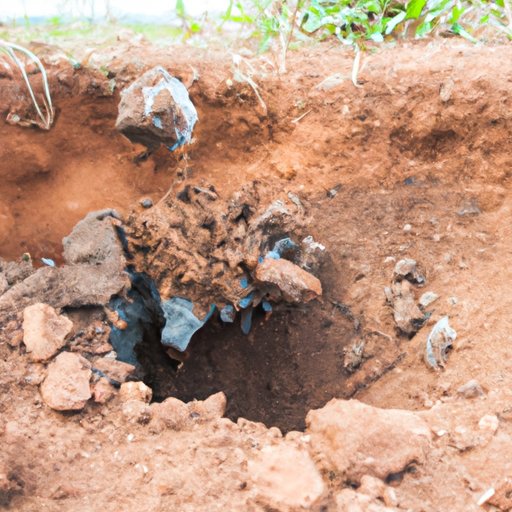Introduction
Well-drained soil is a gardener’s best friend. It’s essential for healthy plants and helps to improve the overall health of a garden. But what exactly is well-drained soil and why is it so important? In this article, we’ll explore the benefits of having well-drained soil and provide a guide for improving and maintaining healthy soil drainage.
What is Well-Drained Soil and Why is it Important?
Well-drained soil is soil that allows water to move freely through it, rather than pooling or getting stuck in certain areas. This type of soil has good air circulation and holds enough moisture to support plant growth without becoming waterlogged. According to the University of Maryland Extension, “Well-drained soils allow excess water to drain away quickly, preventing root rot and other problems caused by standing water.”
Having well-drained soil is essential for growing healthy plants and vegetables. Plants need oxygen to survive, and if the soil is too wet, they won’t get enough of it. Wet soil also encourages the growth of harmful fungi and bacteria which can damage the roots of plants. Poorly drained soil can lead to plant diseases, stunted growth, and death.
The Basics of Well-Drained Soil for Gardeners
Gardeners should be aware of the basics of well-drained soil and how to identify and improve it. To start, it’s important to understand the components of soil that affect drainage. Clay soils are made up of small particles that pack together tightly, making it difficult for water to move through them. Sandy soils are made up of large particles that don’t hold onto water very well, so they tend to drain more quickly.
It’s also important to know how to identify poorly drained soil. If water pools on top of the soil and doesn’t soak in after a few minutes, that is a sign of poor drainage. Other signs include wilting or dying plants, or an abundance of weeds or moss growing in the area.
A Guide to Improving Your Soil’s Drainage
If you have identified poorly drained soil in your garden, there are steps you can take to improve it. One way is to add organic matter such as compost, manure, or bark chips to the soil. This will increase the amount of air spaces in the soil, allowing water to drain more easily. You can also create raised beds to improve soil drainage. The additional height will help the water to run off quickly and prevent it from pooling in the soil.
Another option is to use sand or gravel to improve drainage. By mixing these materials into the soil, you can create larger spaces for water to flow through. However, keep in mind that adding too much sand or gravel can make the soil too dry and actually reduce drainage. Be sure to consult with a professional before adding any materials to your soil.
How to Identify Poorly Drained Soil
As mentioned earlier, one of the most common signs of poorly drained soil is water pooling on top of the soil and not soaking in after a few minutes. Other signs include wilting or dying plants, or an abundance of weeds or moss in the area.
Other causes of poor soil drainage include compacted soil, heavy clay soil, or soil that has a high salt content. Compacted soil can occur when the soil is walked on or driven over frequently, which prevents water from draining properly. Heavy clay soil is made up of small particles that can clump together, blocking the movement of water through the soil. High salt levels can also contribute to poor drainage, as the salts can accumulate in the soil and prevent water from moving through it.
Steps for Creating Well-Drained Soil in Your Garden
Once you’ve identified poorly drained soil, you can take steps to improve it. Adding organic matter such as compost or manure can help to increase the amount of air spaces in the soil, allowing water to drain more easily. You can also create raised beds to improve soil drainage, or add sand or gravel to create larger spaces for water to flow through.
When preparing the soil for planting, mix in some organic matter to improve drainage and aeration. Additionally, be sure to choose plants that are suited for your soil type. Some plants prefer moist soil conditions, while others do better in well-drained soil. Choosing the right plants for your soil type will help ensure that your plants get the water and oxygen they need to thrive.
Tips for Maintaining Healthy Well-Drained Soil
Once you have improved the drainage in your soil, it’s important to maintain it. Regularly adding organic matter to the soil can help to keep it well-drained. Additionally, avoid compacting the soil by walking or driving on it. If necessary, create pathways around your garden to minimize foot traffic.
Finally, mulching your soil can help to improve and maintain healthy soil drainage. Mulch acts like a sponge, absorbing excess moisture and helping to keep the soil from becoming waterlogged. It also helps to keep weeds at bay and adds nutrients to the soil.
Conclusion
Well-drained soil is essential for healthy plants and gardens. It allows water to move freely through the soil and provides oxygen to the roots of plants. Poorly drained soil can lead to root rot, plant diseases, and stunted growth. Knowing how to identify and improve poorly drained soil is important for any gardener.
To improve soil drainage, adding organic matter, creating raised beds, and using sand or gravel can all be effective strategies. Additionally, mulching your soil can help to maintain healthy soil drainage over time. By following these tips, you can ensure that your plants get the water and oxygen they need to thrive.
(Note: Is this article not meeting your expectations? Do you have knowledge or insights to share? Unlock new opportunities and expand your reach by joining our authors team. Click Registration to join us and share your expertise with our readers.)
